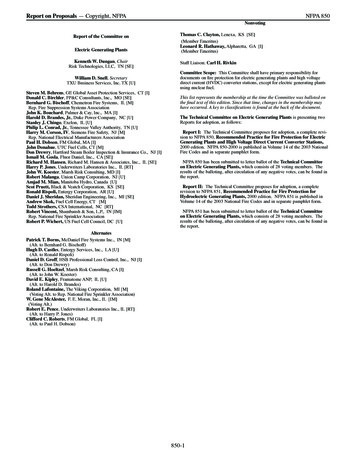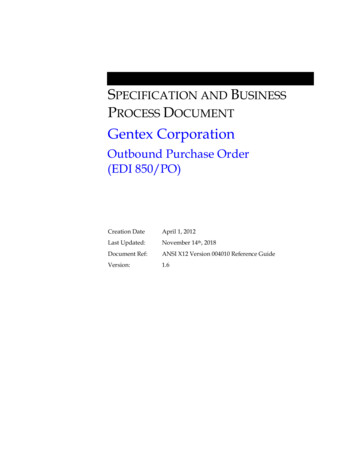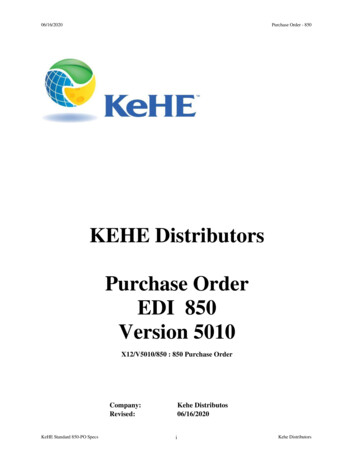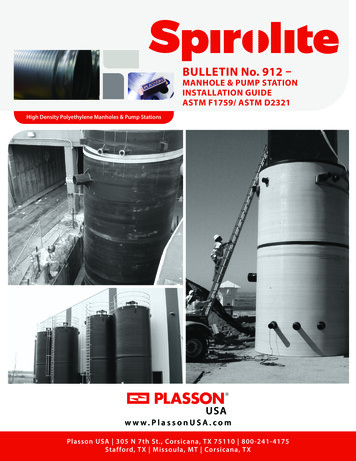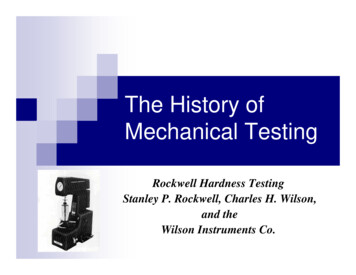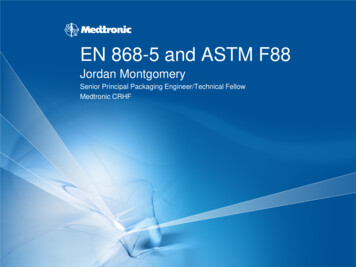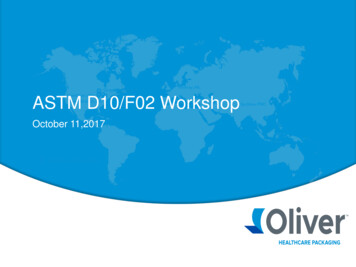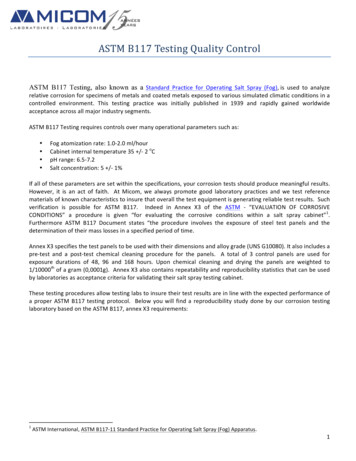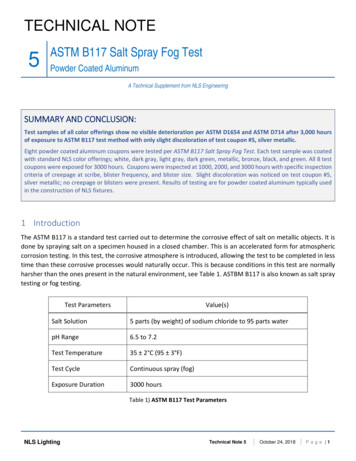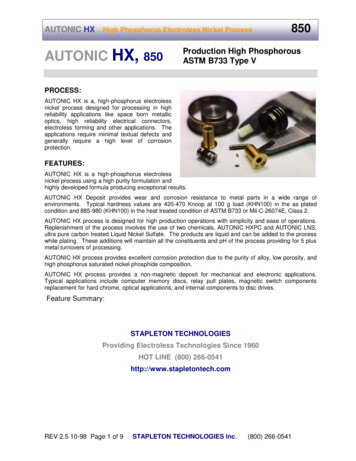
Transcription
AUTONIC HX High Phosphorus Electroless Nickel ProcessAUTONIC HX, 850850Production High PhosphorousASTM B733 Type VPROCESS:AUTONIC HX is a, high-phosphorus electrolessnickel process designed for processing in highreliability applications like space born metallicoptics, high reliability electrical connectors,electroless forming and other applications. Theapplications require minimal textual defects andgenerally require a high level of corrosionprotection.FEATURES:AUTONIC HX is a high-phosphorus electrolessnickel process using a high purity formulation andhighly developed formula producing exceptional results.AUTONIC HX Deposit provides wear and corrosion resistance to metal parts in a wide range ofenvironments. Typical hardness values are 420-470 Knoop at 100 g load (KHN100) in the as platedcondition and 885-980 (KHN100) in the heat treated condition of ASTM B733 or Mil-C-26074E, Class 2.AUTONIC HX process is designed for high production operations with simplicity and ease of operations.Replenishment of the process involves the use of two chemicals, AUTONIC HXPC and AUTONIC LNS,ultra pure carbon treated Liquid Nickel Sulfate. The products are liquid and can be added to the processwhile plating. These additions will maintain all the constituents and pH of the process providing for 5 plusmetal turnovers of processing.AUTONIC HX process provides excellent corrosion protection due to the purity of alloy, low porosity, andhigh phosphorus saturated nickel phosphide composition.AUTONIC HX process provides a non-magnetic deposit for mechanical and electronic applications.Typical applications include computer memory discs, relay pull plates, magnetic switch componentsreplacement for hard chrome, optical applications, and internal components to disc drives.Feature Summary:STAPLETON TECHNOLOGIESProviding Electroless Technologies Since 1960HOT LINE (800) 266-0541http://www.stapletontech.comREV 2.5 10-98 Page 1 of 9STAPLETON TECHNOLOGIES Inc.(800) 266-0541
AUTONIC HX High Phosphorus Electroless Nickel Process850DEPOSIT PROPERTIES AUTONIC HX DEPOSITElectroless Nickel Deposits can be classified into four types. These are based on the percent ofphosphorus in the coating which can represent significant differences in performance of the alloys. Theprimary differences are in structure where ultra high phosphorus deposits of the AUTONIC HX, 11.5% to13%, are free of Ni(111) both before and after heat treatment. This produces a deposit which is morecorrosion resistant to most environments and is non magnetic.PHYSICALBond Strength to SteelBond Strength to AluminumElongationTensile StrengthInternal StressThermal Coefficient of ExpansionMelting PointElectrical Resistivity90,000 PSI - 620 MPa45,000 PSI - 310 MPa0.7 to 1.2 %80 - 90 KSI2.2 KSI Tensile as plated1.2 to 1.4 X 10-5881o (C)80 - 110 X 10-6 ohm-cmCOMPOSITIONNickelPhosphorusTraceBalance10.2% to 11.5%0.15 or lessHARDNESS440 - 480 KHN100g885 - 980 KHN100gAs PlatedHeat treated 700o (F) for 1 hourSTRUCTUREIn the as plated condition the deposit is amorphous. Upon heating to 220o (C) thedeposit will start to crystallize and NiP3 will form. The amount and orientation of thenickel will control the physical properties of the deposit.CORROSION RESISTANCEThe AUTONIC HX deposit has excellent corrosion resistance in many ImmersionWater, Brine 3.5% NaCl & Sat. CO2 9.8 mpyWater, Brine 3.5% NaCl & Sat H2S 0.02 mpyWater, Sea 3.5%0.08 mpy5 mpynilnil(for a complete list of corrosion rates see "State of the Science")PorosityFerroxyl on steel panels with 1 mil Passes with no blue spotsASTM B117 Neutral Salt on steel panels with 1 mil has Passed 20,000 hours.WEAR RESISTANCEAUTONIC HX deposits are hard and resistant to abrasion and adhesive wear applications. Typical wearrates for the coating are 12 to 16 mg/1000 cycles Taber Abrader for the as plated condition and 6 - 12gm/1000 cycles for the precipitate hardened depositsREV 2.5 10-98 Page 2 of 9STAPLETON TECHNOLOGIES Inc.(800) 266-0541
850AUTONIC HX High Phosphorus Electroless Nickel ProcessOPERATING THE AUTONIC HX PROCESSThe AUTONIC HX Process is designed for ease of operations and process control. To operate theprocess the plater must be able to check the nickel concentration and pH and make adjustments to theprocess as required.oThe plating process is operated in a specially designed process tank. This tank heats the solution to 90 Cand filters it through a 5 micron bag at 10 to 20 times the volume of the tank each hour.To maintain an efficient operation, the solution should be heated with a low density heat source and partsshould be loaded when the operating temperature is reached. When all the parts are processed for theoday the heat should be reduced to below 50 C with the filter operating and air agitation off.The AUTONIC Series processes use a high purity nickel sulfate provided. by STAPLETONTECHNOLOGIES. The AUTONIC LNS should be used to insure only the superior solution performance.While the process is operating, the parts will consume nickel ions and reducing agent, thereby requiringtheir replacement to maintain the plating reaction. The amount of nickel consumed is generally measuredin metal turnovers where 1 cycle is equal to a 100% replacement of the nickel metal in the originalsolution. The amount of reducing agent used is dependent on the amount of nickel consumed and will bereplaced when the addition of AUTONIC HXPC.Table 1, AUTONIC HX MAKE-UP FORMULAVolume Tank100150200250300 500750AUTONIC HXPA150 ml/l1522.53037.54575112GALAUTONIC50 ml/l57.51012.5152537GALLNS(5#/gal)PROCEDURES FOR MAKING UP A NEW AUTONIC HX SOLUTION1. Fill approximately 2/3 of the final working volume of cold deionized water into aclean plating tank.2. Add the AUTONIC HXPA to the plating tank.3. Fill the tank to 95% percent volume with Deionized water.4. Add the AUTONIC LNS and mix.5. Record the new solution in a process log.6. Start using your New AUTONIC SolutionREV 2.5 10-98 Page 3 of 9STAPLETON TECHNOLOGIES Inc.(800) 266-0541
850AUTONIC HX High Phosphorus Electroless Nickel ProcessTable 2, SUMMARY of OPERATING CONDITIONSAt StartUCLLCLControlPointFrequencyof Analysis6.6 g/l35 g/l4.4916.6 g/l42 g/l4.7953.5 g/l33 g/l4.1895.8 g/l35.5 g/l4.491.5 - 4 hr.4 - 8 hr.5 - 2 hr.5 - 2 hr.ConditionsNickel MetalHypophosphitepH (Electrometric)Temperature (C)PROCESS CONDITIONS and OPERATIONSThe AUTONIC HX process is simple to operate. A list of operating conditions can be found in TABLE 2.The major control is provided by checking for nickel using an EDTA Titration and from the resultscomputing an addition of AUTONIC maintenance concentrates. These additions will maintain thechemistry, adding all the necessary chemicals to sustain the reaction. This procedure is required everytime the solution uses 10% to 20% of the available nickel metal.The Temperature and pH are also important in sustaining the reaction and therefore should also becontrolled. The temperature causes the reaction to proceed and ultimately controls the rate and thicknessof the plating. While the pH effects the alloy and plating rate it will also effect the plating rate. Lowertemperature and pH will lower the plating rate.In TABLE 2 the Upper Control Limit (UCL), Lower Control Limit (LCL), Control Point and recommendedfrequency of analysis are given. By adhering to these control points you will be able to produce consistentquality and high performance at the lowest possible cost.Table 3, ADDITION SCHEDULE for AUTONIC HX ProcessNickel g/lActivity10093888175696357%EDTA Na2 mls109.38.88.17.56.96.35.7AUTONIC HXPC00.701.21.902.503.103.103.10AUTONIC LNS(5#/gal)00.350.60.851.251.551.551.55AUTONIC HXPC01.753.004.756.257.757.757.75AUTONIC LNS00.871.502.383.123.873.873.87100 GALLONS250 GALLONSREV 2.5 10-98 Page 4 of 9STAPLETON TECHNOLOGIES Inc.(800) 266-0541
AUTONIC HX High Phosphorus Electroless Nickel Process850GETTING THE MOST OUT OF YOUR AUTONIC HX PROCESS1. The solution operates most efficiently when it is plating with a load of between 30 to 90 square inchesper gallon with mechanical agitation.2. Possible contaminates from the shop or parts should be controlled as much as possible. Thesecontaminates can be in the form of organics, metals, or solid materials. They can be airborne, on the part,or waterborne. A clean shop with processes that are maintained correctly will help insure excellentoperations and maximum performance of the deposit with minimum costs of operations.3. The AUTONIC Process will produce the most consistent deposits when it is operated in the 80% to90% activity range. To operate in this range it is advisable to have the person who is plating, titrate andmake the additions.4. The AUTONIC Process is designed to be operated with continuous filtration through a 5 micron bag. Itis advisable for the pump filter system be sized to move 20 plus times the volume of the solution in onehour. This high filtration will remove any unwanted particles which may have be in the process and insurethat as the solution ages and at boiling the pump will still be providing in excess of 20 turnovers per hour.5. When the process reaches about 350% or 3.5 times the original nickel metal it is time to think aboutplating the solution down to 50%, waste treating the solution and making up a new solution. With this typeof approach you will be able to operate at the most economical point, using nearly 90% of all the nickelmetal.6. The AUTONIC HX Process can be loaded with parts up to 140 square inches per gallon. Working the2solutions hard (60 to 90 in /gal) after the first day of operation will provide the most efficient production for2both chemicals and facility. Low loading (5 to 20 in /gal) will have the effect of reducing the efficiency ofthe process and require additional replenishment chemicals to sustain the plating rate.DAILY CARE1. Cover the tank when you are not loading or unloading the tank.2. Strip the tank with 20% to 30% nitric acid at the end of the production run if any significant nickel hasplated onto the sides or bottom. This will help eliminate roughness and the significant loss of chemicals.After stripping the tank and piping you should always rinse and neutralize the system with a dilute solutionof ammonium hydroxide. Small concentrations of nitric acid in the solution may cause a dull or streakeddeposit. The addition of 5 g/l of sulfamic acid along with heating to plating temperature to 1 hour shouldcorrect the problem.3. Turn off the heat when the solution is not going to be used for several hours. Prolonged heating with airagitation and no work in the tank will cause a slight oxidation of the reducing agents and subsequentlyreduce the efficiency of the process.4. Always check the pH when you test for nickel. The results should be noted in a log and any correctionrequired should be made using dilute sulfuric acid or ammonium hydroxide.REV 2.5 10-98 Page 5 of 9STAPLETON TECHNOLOGIES Inc.(800) 266-0541
AUTONIC HX High Phosphorus Electroless Nickel Process850GENERAL EQUIPMENT INFORMATIONFiltration - Continuous filtration through 1 to 5 micron polypropylene filter bag that is elevated above thesolution is recommended. This produces a pressure differential to cause filtration and removes the highconcentration of heat from the filter area.With the bag elevated, any plateout or activity in the solution can be detected and corrective action takenbefore a problem is evident.Tank and Materials of Construction - All tanks, piping, racks and carriers which come in contact with thesolution should be made of CPVC, Poly-propylene, 316LC Stainless Steel, or PVDF. The electrolessnickel solution and stripping solutions are corrosive and care should be taken to prevent contact withelectrical and mechanical systems.Agitation - Mechanical agitation is recommended when the process is operating. A minimal loss of about5% per day of reducing agent will occur when using air agitation. This loss can be minimized by notoperating the air agitation and heaters when the tank is free of work. Prolonged heating and air willaccelerate the oxidation of sodium hypophosphite.Ventilation - The vapor from AUTONIC HX plating process is inherently corrosive due to the highconcentration of salts in the material. All ventilation equipment should be constructed with poly-propylene,PVC or fiberglass to insure good equipment life and a healthy area for the platers.REV 2.5 10-98 Page 6 of 9STAPLETON TECHNOLOGIES Inc.(800) 266-0541
AUTONIC HX High Phosphorus Electroless Nickel Process850TITLE: Analysis for Nickel MetalSCOPE: This method is a direct titration for nickel metal using EDTA. The procedure isquick and will work with automatic titrators using ampermetric or spectrometric probes.APPARATUS:1. Erlenmeyer flask 250 ml2. Automatic burette3. Chemicalsa. Distilled waterb. Ammonium hydroxidec. 35% Triethanolamined. Murexide Indicator in sodium chloridee. 0.0575 M EDTA Na2 SolutionPROCEDURE:1. Add exactly 5.0 ml of plating bath into the Erlenmeyer flask.2. Add about 100 mls of distilled water to the flask.3. Add 20 mls of Ammonium hydroxide to the flask.4. Add 10 mls of 35% Triethanolamine5. Add about 0.2 g of Murexide Indicator Mix to theflask. The solution should be light straw color.6 Titrate immediately with standard 0.0575 M EDTA Na2 Solution topurple endpoint.ANALYSIS:Nickel oz/gal (MLS 0.0575M EDTA Na2) x .0884Nickel g/l (MLS 0.0575M EDTA Na2) x 0.6624REV 2.5 10-98 Page 7 of 9STAPLETON TECHNOLOGIES Inc.(800) 266-0541
AUTONIC HX High Phosphorus Electroless Nickel Process850TITLE: Analysis for Sodium HypophosphiteSCOPE: This is a direct titration for hypophosphite using indirect titration for iodateusing thiosulfate. The method takes 30 minutes and can be automated using automatictitrators.APPARATUS:1. Erlenmeyer flask 250 ml with stopper2. 2 Automatic burettes, 25ml3. 1x10 ml pipette4. Chemicalsa. Distilled waterb. 0.1N Iodinec.
ASTM B733 Type V . AUTONIC HX High Phosphorus Electroless Nickel Process 850 REV 2.5 10-98 Page 2 of 9 STAPLETON TECHNOLOGIES Inc. (800) 266-0541 DEPOSIT PROPERTIES AUTONIC HX DEPOSIT Electroless Nickel Deposits can be classified into four types. These are based on the percent of phosphorus in the coating which can represent significant differences in performance of the alloys.
